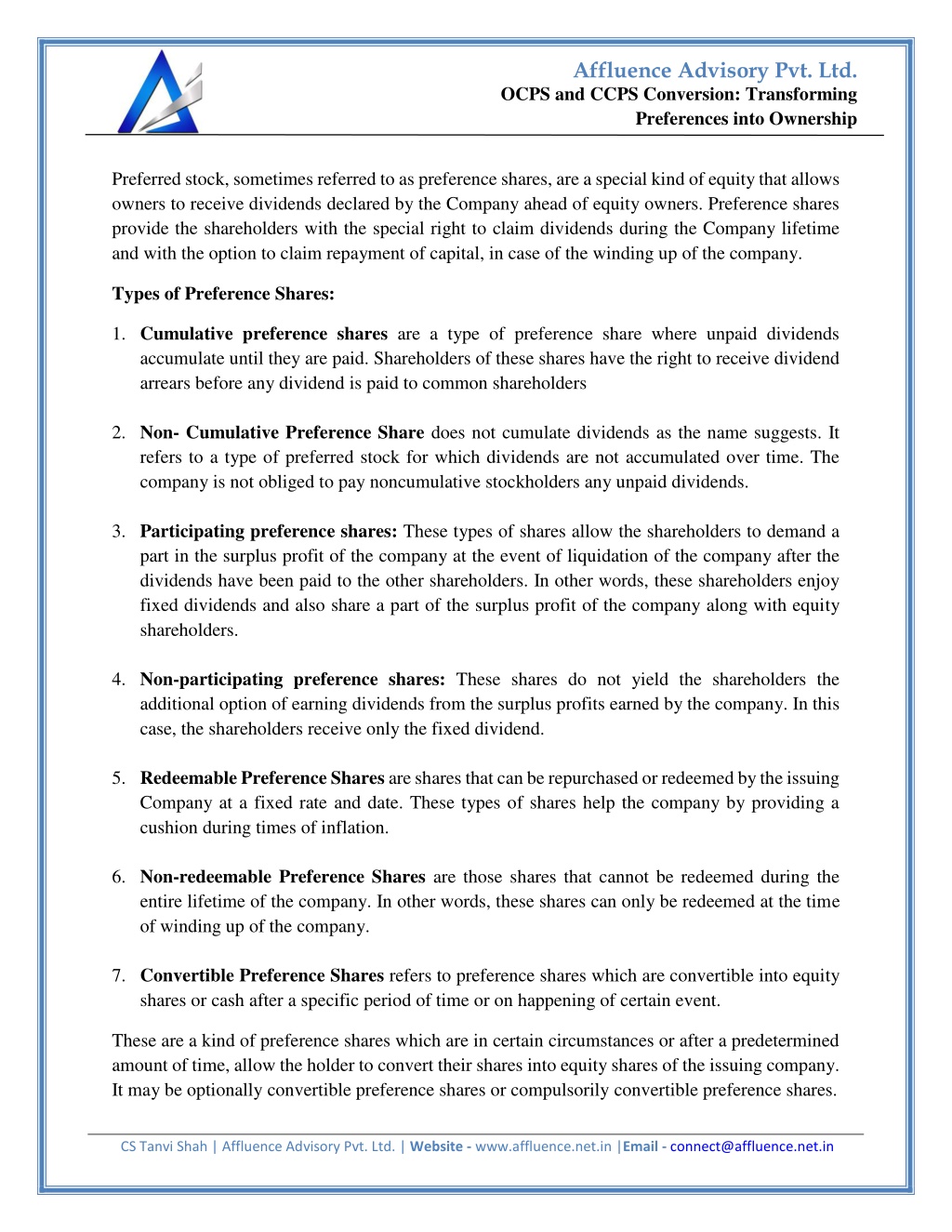
OCPS and CCPS Conversion- Transforming Preferences into Ownership
The content details various types of preference shares, including OCPS and CCPS, highlighting their roles in providing fixed dividends, flexibility in capital raising, and options for equity conversion. It also outlines the procedural steps for conve
Download Presentation

Please find below an Image/Link to download the presentation.
The content on the website is provided AS IS for your information and personal use only. It may not be sold, licensed, or shared on other websites without obtaining consent from the author. Download presentation by click this link. If you encounter any issues during the download, it is possible that the publisher has removed the file from their server.
E N D
Presentation Transcript
Affluence Advisory Pvt. Ltd. OCPS and CCPS Conversion: Transforming Preferences into Ownership Preferred stock, sometimes referred to as preference shares, are a special kind of equity that allows owners to receive dividends declared by the Company ahead of equity owners. Preference shares provide the shareholders with the special right to claim dividends during the Company lifetime and with the option to claim repayment of capital, in case of the winding up of the company. Types of Preference Shares: 1.Cumulative preference shares are a type of preference share where unpaid dividends accumulate until they are paid. Shareholders of these shares have the right to receive dividend arrears before any dividend is paid to common shareholders 2.Non- Cumulative Preference Share does not cumulate dividends as the name suggests. It refers to a type of preferred stock for which dividends are not accumulated over time. The company is not obliged to pay noncumulative stockholders any unpaid dividends. 3.Participating preference shares: These types of shares allow the shareholders to demand a part in the surplus profit of the company at the event of liquidation of the company after the dividends have been paid to the other shareholders. In other words, these shareholders enjoy fixed dividends and also share a part of the surplus profit of the company along with equity shareholders. 4.Non-participating preference shares: These shares do not yield the shareholders the additional option of earning dividends from the surplus profits earned by the company. In this case, the shareholders receive only the fixed dividend. 5.Redeemable Preference Shares are shares that can be repurchased or redeemed by the issuing Company at a fixed rate and date. These types of shares help the company by providing a cushion during times of inflation. 6.Non-redeemable Preference Shares are those shares that cannot be redeemed during the entire lifetime of the company. In other words, these shares can only be redeemed at the time of winding up of the company. 7.Convertible Preference Shares refers to preference shares which are convertible into equity shares or cash after a specific period of time or on happening of certain event. These are a kind of preference shares which are in certain circumstances or after a predetermined amount of time, allow the holder to convert their shares into equity shares of the issuing company. It may be optionally convertible preference shares or compulsorily convertible preference shares. CS Tanvi Shah | Affluence Advisory Pvt. Ltd. | Website - www.affluence.net.in |Email - connect@affluence.net.in
Affluence Advisory Pvt. Ltd. OCPS and CCPS Conversion: Transforming Preferences into Ownership The Company may issue OCPS depending on their strategic goals. It is a strategic financial instrument that balances the need for raising capital with managing ownership and control dynamics within the company. Following are some common causes: 1.Capital Infusion: With OCPS, Companies may raise capital without immediately diluting their equity ownership, as the conversion to equity being optional and may occur at a later date helping the promoters to borrow timeframe to defer the conversion with meeting the capital requirements of the Company at the same time. 2.Flexibility: OCPS offers flexibility in financing as it provides the benefits of both debt and equity until the conversion option is exercised by the company. 3.Pleasing to Investors: OCPS are attractive to investors who are looking for regular income in the form of fixed dividends with the potential of capital appreciation upon exercising the conversion option. 4.Strategic Alliance: Companies may issue OCPS as a component of strategic alliances, such as mergers or acquisitions, whereby the preference shareholders' interests can eventually be aligned with equity shareholders' upon the execution of the conversion option. 5.Detention of Voting Power: With the help of OCPS, the company can raise capital without immediately increasing the number of shareholders with voting rights. 6.Financial Restructuring: OCPS also helps during financial restructuring to convert debt into equity, offering creditors a stake in the company with future equity potential. 7.Balance Sheet Management: OCPS can be set up to appear as equity on the balance sheet, depending on the terms, which can enhance financial ratios and overall financial standing of the company. These are the common reasons behind the issuance of OCPS shares by companies. Procedural Steps for Conversion of Preference Shares (OCPS/CCPS): The Company must first evaluate the maturity date of OCPS/CCPS and determine the conversion price as mentioned in the terms of OCPS/CCPS at the time of issuance. If the Company requires the Valuation to be done, then accordingly Board to appoint Registered Valuer and get the CS Tanvi Shah | Affluence Advisory Pvt. Ltd. | Website - www.affluence.net.in |Email - connect@affluence.net.in
Affluence Advisory Pvt. Ltd. OCPS and CCPS Conversion: Transforming Preferences into Ownership Valuation done for the same. Based on the Valuation, the Company will be able to fix the price of conversion and accordingly get the followed agenda passed in the Board Meeting. If the Company is doing the conversion before maturity, then it is required to obtain consent of shareholders for change in terms via issuing letter with respect to the same in case of OCPS/CCPS or Company to approve the change in terms of preference shares by holding a separate meeting of such preference shareholders. a)Take note of registered valuer report; b)Approve Alteration of Memorandum of Association in case the Authorized Capital Structure requires re-classification as per the provisions of Companies Act, 2013 by passing ordinary resolution; c)Approve the conversion of OCPS/CCPS as the case may be; d)Fix date and time of draft notice of EOGM. Convening of the Extra Ordinary General Meeting to approve the following business: a)Adoption of an Altered Memorandum of Association as per the provisions of Companies Act, 2013, if applicable; b)Approve the Conversion of OCPS/CCPS as the case may be; c)Filing of Form MGT-14. Convening of Board Meeting for following agenda: a)Approve Allotment of Equity shares pursuant to conversion of OCPS/CCPS of the Company; b)Filing of Form PAS-3. Issuance of Share Certificate pursuant to conversion of OCPS/CCPS into Equity shares. Disclaimer:This article provides general information existing at the time of preparation and we take no responsibility to update it with the subsequent changes in the law. The article is intended as a news update and Affluence Advisory neither assumes nor accepts any responsibility for any loss arising to any person acting or refraining from acting as a result of any material contained in this article. It is recommended that professional advice be taken based on specific facts and circumstances. This article does not substitute the need to refer to the original pronouncement CS Tanvi Shah | Affluence Advisory Pvt. Ltd. | Website - www.affluence.net.in |Email - connect@affluence.net.in





















